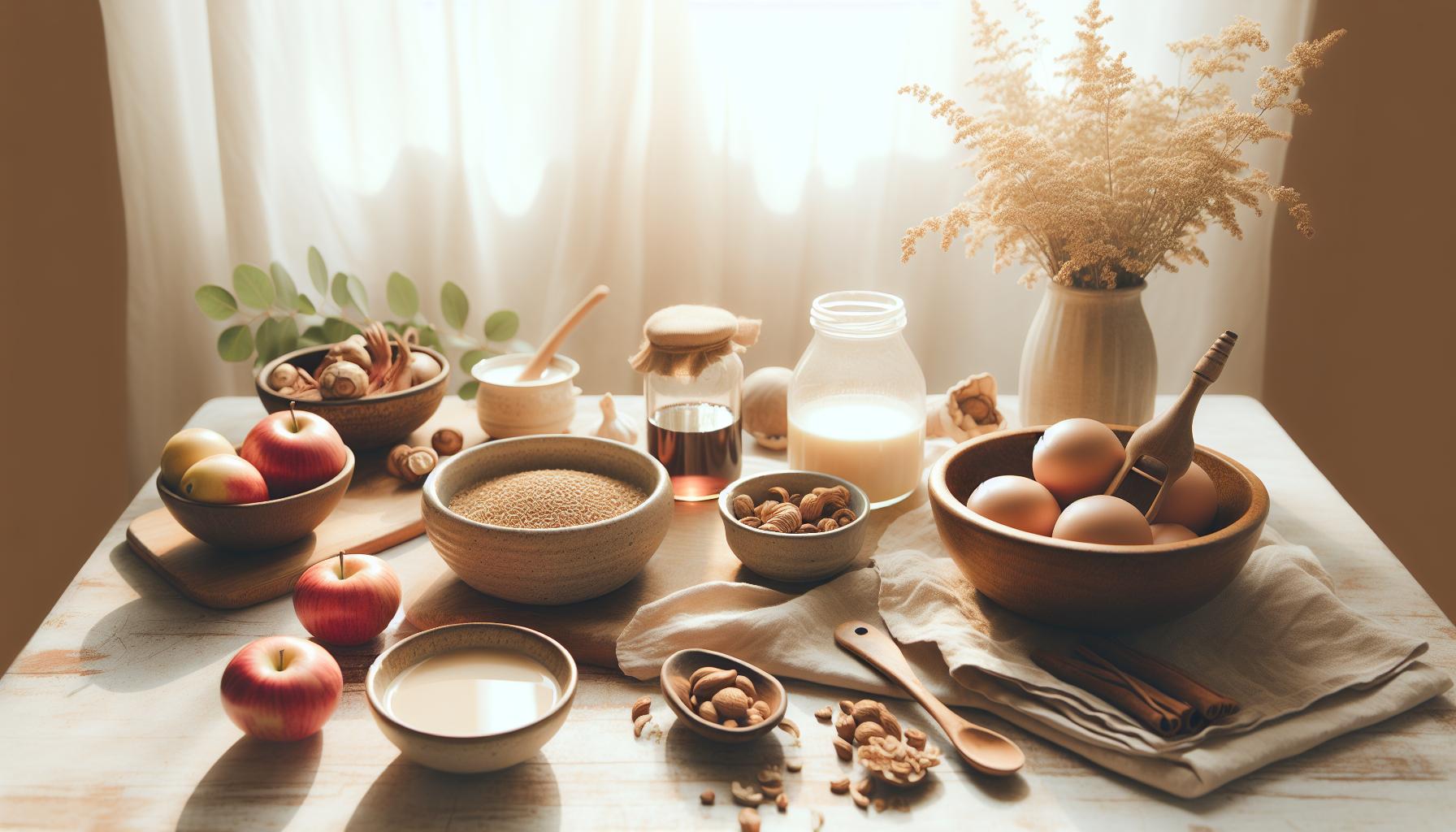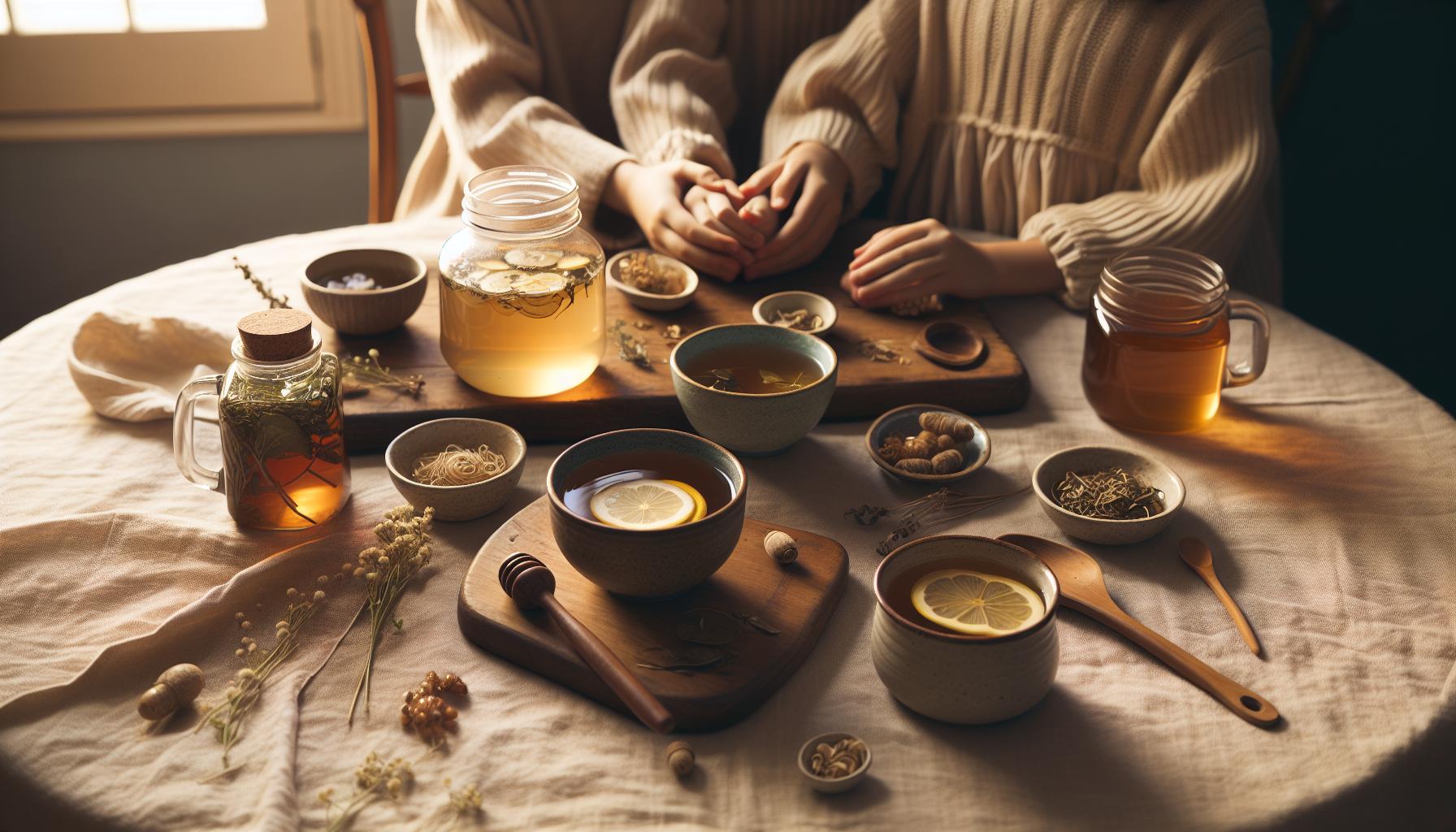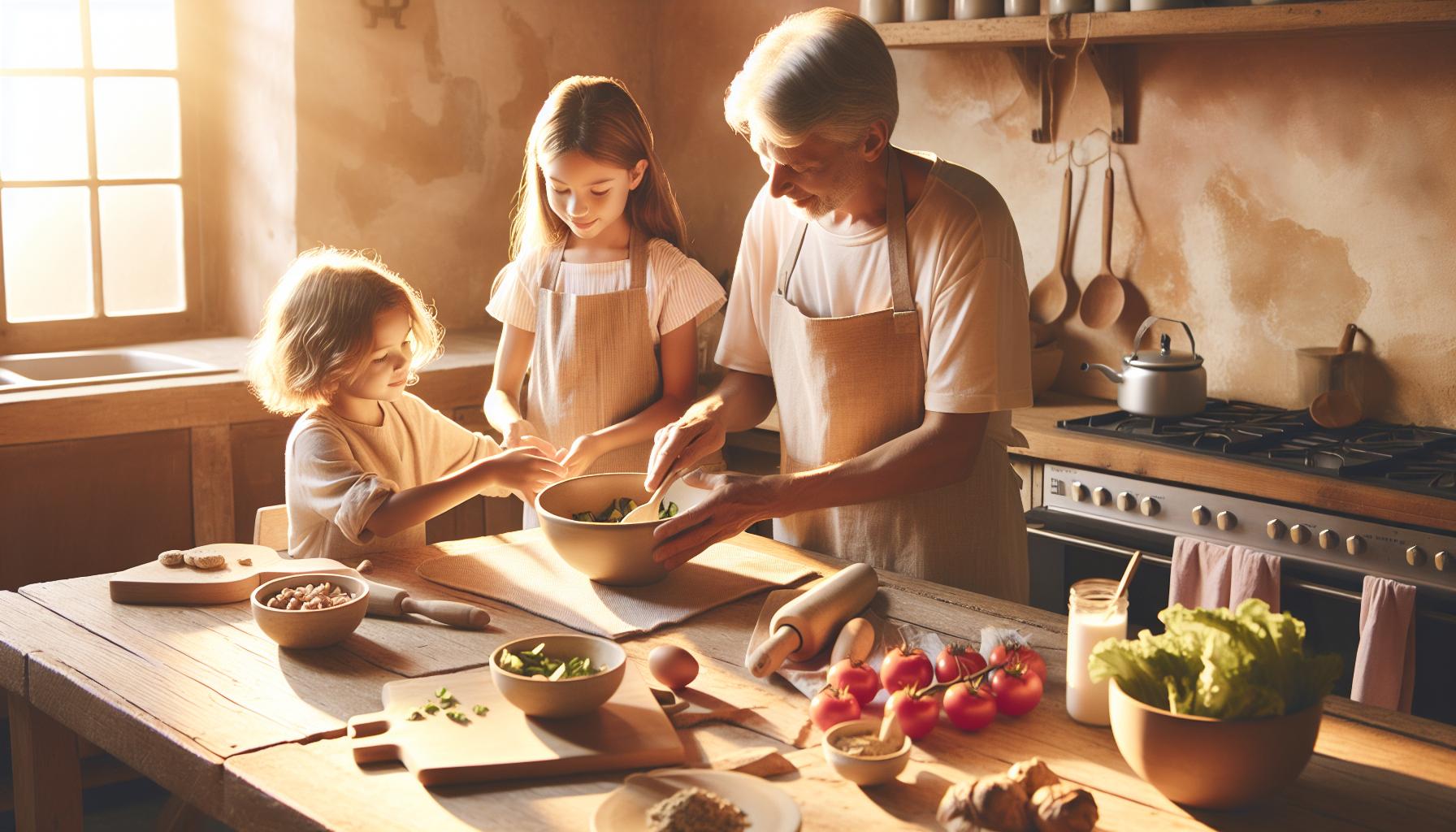After childbirth, many new mothers face a myriad of challenges during recovery, including fatigue and nutritional deficiencies. Traditional Chinese postpartum meals are specifically designed to nourish and revitalize the body. Discover these time-honored recipes, rich in vital ingredients, that not only support recovery but also celebrate the essence of maternal care in Chinese culture.
Understanding the Importance of Postpartum Nutrition in Chinese Culture
Did you know that in Chinese culture, the postpartum period is often referred to as the “confinement period” or “zuo yuezi” (坐月子)? During this crucial time, traditionally lasting 30 to 40 days, mothers are believed to undergo a profound recovery process, and their dietary choices play a critical role in this healing journey.The significance of postpartum nutrition is so deeply ingrained that it is often seen as a basic aspect of a new mother’s physical and mental restoration.
The Role of Nutrition in Recovery
In chinese tradition, postpartum meals are designed not only to nourish the mother but also to help restore balance to her body after childbirth. After enduring the physical toll of pregnancy and delivery, a woman’s body is thought to be weak and in need of strengthening. The emphasis is placed on consuming foods that are warm, nutrient-dense, and rich in healing properties. Here are some critical elements commonly included in traditional Chinese postpartum diets:
- High Protein Foods: Ingredients like chicken, fish, and eggs are believed to help rebuild strength.
- Herbs and Soups: Ingredients such as ginger and black dates are used in nourishing soups that promote blood circulation.
- Whole Grains: Rice and other whole grains provide sustained energy, essential for new mothers.
- Warm Beverages: Hot ginger tea or herbal infusions are favored for their warming qualities to counteract fatigue.
Community support and Shared Wisdom
Cultural norms surrounding postpartum nutrition also emphasize community support; it is common for family members,especially the older generation,to provide guidance and readiness of these special meals. Recipes might include dishes renowned for their restorative properties such as “ginseng chicken soup” or “red date and goji berry porridge.” This communal aspect not only helps the new mother physically but also plays a vital emotional role, fostering connection and nurturing relationships during a transformative life phase.
When considering traditional recipes, itS beneficial to keep in mind food allergies or intolerances, customizing dishes without losing their nutritional essence. Mothers are frequently enough encouraged to embrace this period by enjoying meals that appeal to their taste while simultaneously adhering to the customs that have supported generations before them.
Incorporating the philosophies behind Chinese postpartum meals—where nutrition meets tradition—can provide invaluable support for new mothers, helping them to recover and thrive amid the challenges of motherhood.
Key ingredients in Traditional Chinese Postpartum Dishes
The foundation of traditional Chinese postpartum meals is built on ingredients that promote recovery, enhance milk production, and restore energy levels.These meals are not merely about nourishment; they are a carefully curated selection of components that have been cherished for centuries in Chinese culture for their healing properties. Understanding these key ingredients can provide insight into how they contribute to a mother’s well-being during the critical postpartum period.
Essential Ingredients and Their Benefits
- Black Sesame Seeds: Renowned for their ability to nourish the liver and kidneys, these seeds are also rich in calcium and iron, which are essential for replenishing a mother’s resources.They are commonly ground into a paste or sprinkled over dishes.
- Ginger: A staple in postpartum cooking, ginger promotes digestion and warms the body. It is often added to soups and teas to support recovery and enhance overall vitality.
- Chicken: You might find chicken featured prominently because it is a highly regarded protein source that helps restore strength. Typically, it’s simmered with herbs and spices to create restorative soups that are vital in assisting milk production.
- Goji Berries: Known as a superfood, goji berries are rich in antioxidants and are believed to boost blood circulation and improve overall health. They frequently enough add a hint of sweetness to congee and other dishes.
- Red Dates (jujube): These sweet fruits are excellent for nourishing blood,helping to combat fatigue,and are commonly incorporated into soups and teas to enhance the mother’s energy levels.
- Lotus Seeds: These seeds are highly valued in traditional recipes for their calming properties, which can help alleviate stress during the postpartum recovery phase.
Table of Key Ingredients and Their Nutritional Benefits
| Ingredient | Benefits |
|---|---|
| Black Sesame Seeds | Rich in calcium and iron; nourishes liver and kidneys. |
| Ginger | Aids digestion and boosts warmth; enhances vitality. |
| Chicken | High in protein; restores strength and aids milk production. |
| goji Berries | Rich in antioxidants; improves blood circulation. |
| Red dates | Nourishes blood; combats fatigue and enhances energy. |
| Lotus Seeds | Calming properties; promotes relaxation during recovery. |
By integrating these nourishing ingredients into daily meals, families honor traditional practices while also ensuring that postpartum recovery is as smooth and healthy as possible.Understanding the role of each element not only enriches the cooking experience but also emphasizes the cultural significance behind Chinese postpartum meals, making them vital in supporting new mothers through this transformative time.
Nourishing Recipes to Support Healing After Childbirth
The journey of motherhood, particularly in the crucial weeks following childbirth, can be both transformative and demanding. Nutrition during this period is essential, offering not just sustenance but also healing properties crucial for recovery. Embracing traditional Chinese postpartum meals can provide nurturing support, allowing new mothers to replenish their energies and aid bodily recovery.
Hearty Soups for Healing
One of the cornerstones of Chinese postpartum nutrition is the preparation of nourishing soups. These recipes often feature a base of medicinal ingredients, including goji berries, Chinese dates, and ginger, which are believed to warm the body, enhance circulation, and promote healing. Here are a few popular soup options:
- Chicken Ginger Soup: Simmer fresh ginger and tender chicken with rice wine and goji berries to create a dish rich in protein and antioxidants.
- Red Dates and Black Wood Ear Fungus Soup: This sweet and savory blend aids in blood circulation and replenishes essential nutrients.
- Beef Bone Soup: Slow-cooked with herbs and spices, this soup is nutrient-dense, packed with collagen and minerals necessary for recovery.
Wholesome Congee for Sustenance
Congee, a rice porridge, is a beloved staple in Chinese postpartum meals. It is easy to digest and can be enriched with various toppings to suit individual tastes and nutrient needs. Here are practical ideas for enhancing your congee:
- Chicken Congee: Add shredded chicken and slices of ginger for an energy-boosting meal.
- Seafood congee: Incorporate fish or shrimp to provide vital Omega-3 fatty acids which are beneficial for brain health.
- Vegetarian Congee: Include mixed vegetables and tofu for a plant-based version rich in protein and vitamins.
Essential Healing Ingredients
Incorporating specific healing ingredients into meals can substantially enhance the recovery process. Below is a table summarizing key ingredients commonly used in traditional Chinese postpartum recipes, their benefits, and some examples of how to use them:
| Ingredient | Benefits | Usage |
|---|---|---|
| Ginger | Boosts circulation and digestion | Add to soups and congee |
| Goji Berries | Supports immune function and skin health | incorporate into soups and teas |
| Black Sesame Seeds | promotes hair and skin health | sprinkle over dishes or blend in congee |
| Chinese Dates (Jujube) | Rich in vitamins and improves sleep quality | Use in soups or as a sweet snack |
Incorporating these traditional recipes and healing ingredients into your postpartum meals not only nourishes the body but also fulfills a cultural legacy of care and support during this vulnerable time.By prioritizing these wholesome choices, new mothers can promote optimal healing and foster a smoother transition into motherhood.
The Role of Herbal Teas and broths in Recovery
In many cultures, a mother’s recovery after childbirth is seen as a delicate journey that requires careful attention to diet and nourishment. Among the numerous traditions surrounding postpartum care, the inclusion of herbal teas and broths stands out as particularly beneficial. These not only offer hydration but are also deeply rooted in the philosophies of balance and health,vital for new mothers in their recovery.
The therapeutic Properties of Herbal Teas
Herbal teas, rich in vitamins and antioxidants, can play a important role in supporting recovery postpartum. For starters, they are generally caffeine-free, making them gentler for breastfeeding mothers while providing various health benefits. Some popular herbal teas and their benefits include:
- ginger Tea: Known for its anti-inflammatory properties, ginger tea can help ease digestive discomfort and boost energy levels.
- Raspberry Leaf Tea: Frequently enough recommended for new mothers as it strengthens the uterus and helps in postpartum recovery.
- Chamomile Tea: Renowned for its calming effects, it aids in relaxation and can encourage a restful sleep which is crucial during the demanding early days of motherhood.
- Fenugreek Tea: This tea is beneficial for milk production and can support breastfeeding, making it a staple in many traditional postpartum diets.
The Nourishment of Broths
Broths hold a cherished place in the realm of recovery foods, offering a wholesome and restorative option for new mothers. Rich in minerals and easily digestible, they’re particularly ideal for those who may not have a robust appetite. Bone broth, especially, is a traditional remedy praised for its capacity to:
- Support overall joint health, which is essential as mothers bear the physical strains of nursing and caring for a newborn.
- Enhance gut health through the presence of collagen and gelatin, aiding digestion and preventing constipation—common issues for postpartum women.
- Boost immunity and promote healing, providing essential nutrients like calcium, magnesium, and amino acids.
Many families prepare large batches of broth as part of their postpartum meal plan, allowing new mothers to consume it regularly. As a notable example, a nourishing chicken bone broth can be enriched with ginger, garlic, and even seaweed, integrating flavors while amplifying the health benefits, creating a deliciously comforting meal that aligns with traditional beliefs surrounding postpartum recovery.
| Herbal Tea | Key Benefit |
|---|---|
| Ginger Tea | Reduces inflammation and boosts energy. |
| Raspberry Leaf Tea | Strengthens uterus and aids recovery. |
| Chamomile Tea | Promotes relaxation and sleep. |
| Fenugreek Tea | Supports lactation. |
Incorporating herbal teas and nourishing broths into the dietary framework of Chinese postpartum meals: traditional recipes to aid recovery fosters both physical healing and emotional well-being. They remind new mothers to take a moment for themselves amid the chaos of caring for a newborn, reinforcing the idea that healing begins with self-care.
Balancing Warmth and Nutrition: Cooking Methods that Matter
cooking Methods that Enhance Recovery
Did you know that the way food is prepared can significantly affect its nutritional value and digestibility? For new mothers, particularly in the context of Chinese postpartum meals, understanding the right cooking methods can be crucial for both recovery and health. Traditional recipes are designed to provide warmth and comfort, embodying the principle of nourishing the body during a sensitive time while offering the necessary nutrients to aid healing.
One effective approach to cooking that aligns with the philosophy of Chinese postpartum food is slow cooking. This method allows ingredients to simmer gently, extracting flavors and nutrients without harsh treatments. Dishes like ginger-infused chicken soup not only become incredibly flavorful but also ensure that herbs and spices fully release their healing properties. Here are some suitable methods to consider:
- Steaming: A great way to preserve the vitamins and minerals in foods, steaming is frequently enough used for vegetables and fish, creating light yet nourishing meals.
- Slow Braising: This method involves cooking tougher cuts of meat in broth or sauce, making them tender and easy to digest while retaining moisture and flavor.
- Sautéing with Broths: Using a broth rather of oils allows for healthier fat consumption and adds depth to the flavor of stir-fried dishes, making them both delicious and nutrient-rich.
simple Recipe Table for Postpartum Nourishment
To illustrate how these cooking methods converge in traditional Chinese postpartum meals, here’s a table showcasing a few essential dishes, their main ingredients, and their cooking methods:
| Dish | Main Ingredients | Cooking Method |
|---|---|---|
| Ginger Chicken Soup | Chicken, ginger, garlic, goji berries, black fungus | Slow cooking |
| Steamed Fish with Scallions | White fish, scallions, ginger, soy sauce | Steaming |
| Red Date Congee | Rice, red dates, goji berries, nuts | Slow braising |
| Sautéed Spinach with Garlic | Fresh spinach, garlic, sesame oil | Sautéing with broth |
By embracing these cooking methods, new mothers can create an array of meals that not only provide nutritional benefits but also support warmth and comfort during the postpartum recovery phase. Each dish draws from the tradition of Chinese postpartum meals, amplifying their healing properties through thoughtful preparation.
Adapting Traditional Meals for Modern Moms
Revamping Age-Old Recipes for Today’s Mamas
Navigating the demands of motherhood while trying to uphold traditional practices can be a daunting task. Fortunately,the core principles behind Chinese postpartum meals still resonate with modern dietary needs. By adapting these time-honored recipes, new mothers can enjoy nourishing dishes that promote recovery without sacrificing convenience or taste.
Embracing Convenience Without Compromise
Today’s busy mothers can still honor their heritage while managing tight schedules. Here are some effective strategies:
- Batch Cooking: Prepare larger quantities of traditional dishes, such as herbal chicken soup or red date porridge, and freeze them in individual portions. This practice ensures swift, nourishing meals are always available.
- Ingredient Swaps: If certain traditional ingredients are hard to find,consider substitutions that maintain the nutritional benefits. As a notable example,quinoa can be used as a substitute for traditional rice,adding protein and fiber to the mix.
- One-Pot Wonders: Simplify meal prep with one-pot recipes that reduce cooking time and cleanup. Combining ingredients for soups or stews in a slow cooker preserves flavors and nutrients without the fuss.
Modernizing Key Ingredients
While the essence of Chinese postpartum meals: traditional recipes to aid recovery remains essential, modernizing the ingredients can enhance their appeal and accessibility. Below is a simplified table showcasing common traditional ingredients alongside their modern counterparts:
| Traditional Ingredient | Modern Equivalent |
|---|---|
| Black sesame seeds | Ground flaxseeds |
| Goji berries | Dried cranberries or blueberries |
| Pig’s trotter | Chicken thighs |
| red dates (jujube) | Medjool dates |
By reimagining these traditional meals with ingredients that are both wholesome and readily available,mothers can continue to support their recovery while seamlessly integrating cultural practices into their modern lifestyles. Each delicious adaptation caters not only to recovery but also to the vibrant essence of nurturing oneself during this special time.
Family Involvement: Making Meal Prep a Bonding Experience
The journey of welcoming a new life into the world is one filled with joy, challenges, and endless opportunities for connection.Yet, in the midst of recovery, meal preparation can feel daunting.Embracing the tradition of Chinese postpartum meals offers a wonderful chance for family members to come together, fostering stronger bonds while nourishing the new mother. Instead of seeing meal prep as a chore, it can be transformed into an enjoyable family activity that enhances emotional support during this critical time.
Gathering Around the Kitchen
Imagine a kitchen filled with laughter and conversation, where family members unite to create nourishing dishes that honor tradition and facilitate recovery. Weather it’s sourcing ingredients or assembling recipes, everyone can play a role. Here are some ideas to increase family involvement in meal prep:
- Recipe Research: Dive into the stories behind traditional Chinese postpartum recipes.Gather family members to explore various dishes like ginger chicken soup or red date tea, encouraging them to share their insights or memories associated with each meal.
- Ingredient Prep: Assign roles based on family members’ comfort levels with cooking. One could chop vegetables, while another could measure spices or simmer broth, allowing everyone to contribute to the preparation.
- Cooking Sessions: Host cooking sessions where you prepare multiple meals at once. This could evolve into a communal event, involving grandparents, siblings, or close friends, which enhances feelings of support and togetherness.
- Meal Planning: Involve everyone in planning the week’s meals. Discuss which Chinese postpartum meals will be prepared, and encourage input on flavors or dishes that the mother particularly enjoys or misses.
Creating a Meal Schedule
To make meal prep even more manageable,consider establishing a weekly meal schedule that accommodates the various traditional recipes aimed at aiding recovery. Here’s a simple table to illustrate a potential meal plan:
| day | Meal | Family Member in Charge |
|---|---|---|
| Monday | ginger Chicken Soup | Aunt Mei |
| Tuesday | Red Date and Goji Berry Tea | Grandma Lin |
| Wednesday | Braised Pork with Black Fungus | Sister Jia |
| Thursday | Stir-fried Greens with Garlic | Brother Wei |
| Friday | Lentil Congee | Mother |
Involving the whole family in the preparation of traditional recipes that aid recovery provides not only nourishment but also emotional sustenance. Creating new memories around the kitchen not only honors cultural traditions but also strengthens family ties through shared experiences and collective effort, ultimately contributing to a nurturing surroundings for the new mother and her newborn.
Tips for Creating a Supportive Postpartum Meal Plan
The postpartum period is a unique time that requires special attention to diet and nutrition. In traditional Chinese culture, a carefully crafted meal plan plays a vital role in recovery after childbirth, aiming to restore a woman’s health and vitality. Integrating principles from Chinese Postpartum Meals: Traditional Recipes to aid Recovery can enrich your meal planning process, ensuring that you’re nourishing both your body and spirit during this critical time.
Focus on Nutrient-Dense Foods
One of the primary goals of a postpartum meal plan is to include foods rich in essential nutrients. These should promote healing and support lactation. Consider incorporating:
- Whole grains – Brown rice, whole wheat noodles, and oats are excellent sources of energy and fiber.
- Lean proteins – Items like chicken, fish, and legumes are crucial for muscle repair and overall recovery.
- Healthy fats – Sources such as avocados, nuts, and seeds provide necessary energy and help keep you satiated.
- Fruits and vegetables – Rich in vitamins and minerals, these should be diverse and colorful to ensure an array of nutrients.
Traditional Ingredients That Heal
Incorporating traditional Chinese ingredients can enhance both flavor and health benefits. Here’s a simple table outlining some key ingredients and their benefits:
| Ingredient | Health Benefits |
|---|---|
| Ginger | Supports digestion and reduces inflammation. |
| Red Dates (Jujube) | Boosts energy and helps improve blood circulation. |
| Goji Berries | Rich in antioxidants and supports eye health. |
| Black Sesame Seeds | Known to promote lactation and provide healthy fats. |
Plan for Ease and Convenience
Postpartum recovery can be physically demanding, so practicality is essential. Prepare meals ahead of time and consider batching cooking to ease daily demands. Freezing portions of traditional recipes, such as Chinese Postpartum Meals: Traditional Recipes to Aid Recovery, can ensure a steady supply of nutritious food. Focus on dishes that reheat well, such as:
- Congee with ginger and chicken
- Stewed soup with herbs and goji berries
- Stir-fried greens with garlic
Additionally, don’t hesitate to enlist the help of family or friends for meal preparation. A community approach not only eases the load but also enhances emotional support during this monumental life transition.
Q&A
What are Chinese postpartum meals?
Chinese postpartum meals are specifically prepared dishes designed to support new mothers during their recovery period after childbirth. These meals typically focus on nutrition, providing necessary vitamins and minerals to promote healing and rejuvenation.
These meals often include ingredients believed to enhance blood circulation and replenish energy, such as ginger, black sesame, and various meats. traditional recipes may also incorporate herbs to aid digestion and boost immunity. You can explore some traditional recipes in our article on Traditional Recipes to Aid Recovery.
Why are traditional recipes significant for postpartum recovery?
Traditional recipes are important because they are tailored to meet the specific nutritional needs of postpartum women. They emphasize warmth and nourishment at a time when recovery is critical.
In Chinese culture, the postpartum period is viewed as a time of healing, making these dishes crucial for restoring energy levels and enhancing overall well-being. Ingredients like red dates and longan are commonly used for their restorative properties, helping mothers regain strength for the demands of parenthood.
Can I prepare Chinese postpartum meals at home?
Absolutely! You can prepare Chinese postpartum meals at home with ingredients commonly found at local grocery stores or Asian markets.Many traditional recipes can be adapted to fit your cooking preferences.
Look for recipes that incorporate nourishing staples like bone broth, which is rich in minerals and good for recovery. You can also customize these meals by including seasonal vegetables to enhance flavor and nutrition.
How do Chinese postpartum meals aid recovery?
Chinese postpartum meals aid recovery by providing key nutrients that promote healing and replenishment. Foods rich in iron, protein, and vitamins help restore energy and support recovery.
Additionally, the warming nature of many traditional ingredients, like ginger and garlic, is believed to aid digestion and promote vitality. These meals not only nourish the body but also support emotional well-being through comforting flavors.
What ingredients are commonly found in Chinese postpartum meals?
common ingredients in Chinese postpartum meals include ginger, black sesame seeds, jujubes (red dates), chicken, and fish. These ingredients are favored for their nutritional benefits and believed healing properties.
seasoning and herbs, such as goji berries and angelica root, are also often used to enhance flavor while providing additional health benefits. This well-rounded approach ensures that postpartum women get a holistic boost during recovery.
What are some benefits of eating Chinese postpartum meals?
The benefits of eating Chinese postpartum meals include improved energy levels, faster recovery, and enhanced emotional well-being. these meals frequently enough incorporate wholesome, nutrient-dense ingredients.
Furthermore, because they are designed with a mother’s needs in mind, these foods can aid in lactation and provide essential nutrients that support both mother and baby during the important postpartum period.
How long should I follow a postpartum meal plan?
It is generally recommended to follow a postpartum meal plan for at least 30-40 days after childbirth. This duration helps ensure proper recovery and nourishment during this crucial time.
After this period, you can gradually reintroduce a more varied diet while maintaining some of the nourishing practices learned during these weeks. Listening to your body’s needs is key to determining what works for you.
The Conclusion
As we wrap up our exploration of traditional Chinese postpartum meals, it’s clear that the care and nourishment provided through these recipes play a vital role in recovery and bonding with your new baby. By incorporating ingredients known for their healing properties, you can help your body regain strength while also indulging in flavors that have been cherished through generations.
We encourage you to delve deeper into these nurturing culinary traditions and perhaps try a recipe or two in your own kitchen. Remember, the journey of parenting is filled with challenges, but it’s also a time for connection, growth, and finding. Don’t hesitate to reach out to your community, share your experiences, or seek advice—together, we can support one another through this transformative phase of life.
Explore,experiment,and embrace the warmth of these traditional meals as you navigate your postpartum journey. Your well-being is essential, and with each nourishing bite, you are taking an important step forward in nurturing both yourself and your little one. Happy cooking!






